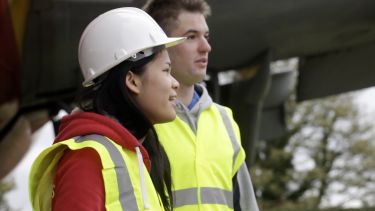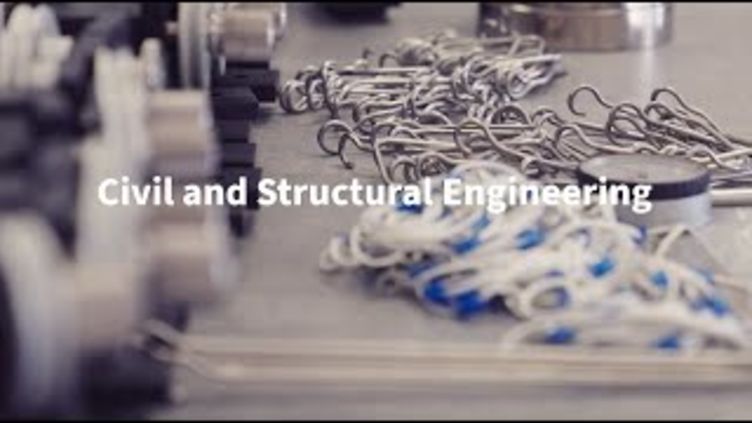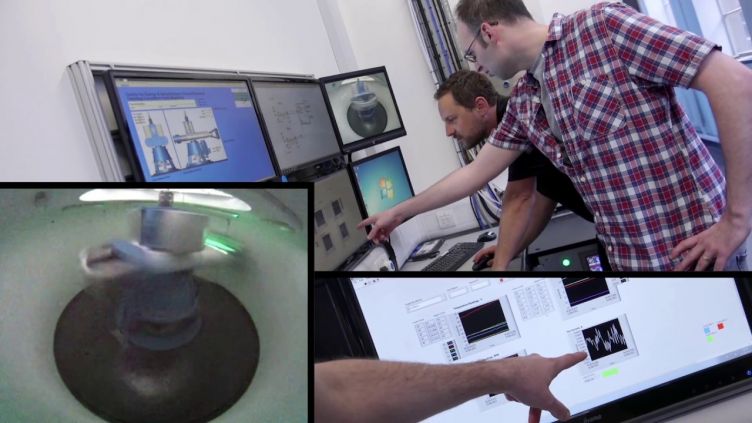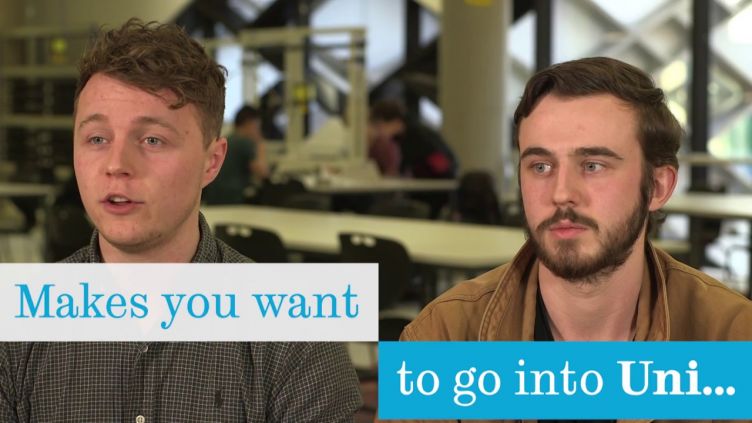Architectural Engineering with an Industrial Placement Year MEng
On this course, you'll study all the engineering disciplines associated with buildings and their infrastructure, and develop an understanding of architectural thinking and practice. You will also gain first-hand industry experience.
-
A Levels
AAA -
UCAS code
2G91 -
Duration
5 years -
Start date
September
- Accredited
- Course fee
- Funding available
- Industry placement
Explore this course:
Course description
Why study this course?
This degree supports a diversity of potential career pathways both within and outside of the built environment.
You’ll learn civil, mechanical, and architectural/planning from specialists in each discipline.
Get hands-on experience, including access to the unique urban flows observatory.
Explore both concept and detailed design for a range of real-world built-environment problems.

Lead the charge to create the next generation of low environmental-impact buildings, using real-world experience from an industrial placement and top-notch knowledge gained from our expert architectural engineers.
There is an increasing demand for building systems engineers with multidisciplinary skills. Study at Sheffield and you'll become the kind of engineer who recognises social responsibility and holistic thinking. Someone ready to step into a career creating buildings which make minimal impact on our environment.
After two years studying the principles of engineering, building infrastructure and architectural perspective, you'll spend a full semester of your third year on an integrated design project.
You’ll unleash your creativity on a grand scale: devising plans for an entire urban regeneration project based on a real site in Sheffield. You'll investigate new methods and construction materials while focusing on passive design measures and low impact systems.
In your fourth year, you will have the opportunity to do an industrial placement year, where you can test your knowledge and further develop your technical skills in a real-life industrial environment.
Finally, in year five you’ll be exposed to advanced methods of analysis and simulation techniques for certain building services, particularly fluids, civil, structural and mechanical engineering.
These will feed into your major investigative project, developing your ability to work independently and carry out research - graduating with all the skills you need to contribute to the continuous development and innovation within the low-impact built-environment of the future.
This degree is accredited by the Chartered Institution of Building Services Engineers (CIBSE), Institution of Mechanical Engineers (IMechE) and the Joint Board of Moderators (JBM), comprising the Institution of Civil Engineers, Institution of Structural Engineers, Institute of Highway Engineers, the Chartered Institution of Highways and Transportation and the Permanent Way Institution, on behalf of the Engineering Council for the purposes of fully meeting the academic requirement for registration as a Chartered Engineer (CEng).
Find more information on the CIBSE and JBM websites.


Modules
A selection of modules are available each year - some examples are below. There may be changes before you start your course. From May of the year of entry, formal programme regulations will be available in our Programme Regulations Finder.
Choose a year to see modules for a level of study:
UCAS code: 2G91
Years: 2025, 2026
Core modules:
- Mathematics and Python Programming
-
This module aims to reinforce and extend students' previous knowledge of mathematics studied before university, and introduces the use of computer programming to solve engineering and mathematical problems.
20 credits
Mathematics is further taught to develop new basic mathematical techniques needed to support the engineering subjects taken at levels 1 and 2. It also provides a foundation for the level 2 mathematics courses in the department. Combined with the mathematics teaching, this module teaches the opensource programming language, Python, which can be used to efficiently solve a variety of practical scientific and numerical problems.
A combination of formal lecture content, tutorials and assisted computer lab sessions, help the students learn and apply mathematical and programming theory. Practice problems are presented showing the links between mathematics and programming learning, to show how the skills learnt can solve practical problems of relevance to the students. - Engineering Surveying
-
In this module you will learn basic engineering surveying skills and the role spatial data plays in civil engineering design and construction. You will gain hands-on experience in using different types of surveying equipment and in basic manipulation of spatial data. You'll gain key transferable skills in metrology and checking data accuracy.
10 credits - Civil and Structural Engineering Mechanics
-
This module is delivered in both the Autumn and Spring Semesters. Teaching in the first semester is designed to provide a basis of knowledge and understanding of elastic structural analysis and will be applied to two key structural forms - trusses and beams. The focus of the second semester is on the analysis of stress, strain and elastic deformation of beams.
20 credits - Thermofluids
-
Architectural Engineers are required to understand design and construct buildings that provide human comfort with minimal energy consumption. This module will develop the fundamental thermofluids basis and the necessary skills and interdisciplinary agility to address this global challenge. The module will give an introduction to the fundamental principles of thermodynamics required to analyse and design engineering processes, and the basic principles of fluid mechanics and their application to flow systems and devices. Real world examples will be used throughout, to highlight the importance of thermofluid systems and their integration with a wide range of engineering areas.
20 credits - Environment and Technology 1
-
The overall aim of the Environment and Technology modules is to provide the knowledge and ability in building technology, environmental design and construction methods that are necessary to undertake design projects in the Design Studio. This module presents principles of planet and place including:
10 credits
- climate literacy and climate justice, building in the era of the climate emergency
- principles of regenerative design and ecology
- historical overview of solar architecture - Environment and Technology 2
-
The overall aim of the Environment and Technology modules is to provide the knowledge and ability in building technology, environmental design and construction methods that are necessary to undertake design projects in the Design Studio.
10 credits
This module (ALA104) and the preceding module (ALA103) are paired thematically and present principles of planet and place, including in this module:
- designing with site and context
- designing with climate and microclimate
- designing with passive solar principles
- designing with air and water
- designing with materials and layers - Soil Mechanics
-
This module is an introductory module to the use of soils in engineering practice. As soils are a naturally varying material, the creation of different soil types is first discussed giving the student a background in why soils differ. This then progresses into the engineering classification of soils followed by the design of simple geotechnical structures. These include retaining walls and earth embankments.
10 credits - Introduction to Structural Materials Engineering
-
This lecture course focusses on materials for structural applications and covers all the main classes of materials (ceramics, metals, polymers, natural materials and composites), describing the properties that they show, the root cause of their properties, the structure, and how we can affect this by processing to get the properties we want. The course will also introduce some ways that the best material for a purpose can be selected.
10 credits - Global Engineering Challenge Week
-
The Faculty-wide Global Engineering Challenge Week is a compulsory part of the first-year programme. The project has been designed to develop student academic, transferable and employability skills as well as widen their horizons as global citizens. Working in multi-disciplinary groups of 5-6, for a full week, all students in the Faculty choose from a number of projects arranged under a range of themes including Water, Waste Management, Energy and Digital with scenarios set in an overseas location facing economic challenge. Some projects are based on the Engineers Without Borders Engineering for people design challenge*.
*The EWB challenge provides students with the opportunity to learn about design, teamwork and communication through real, inspiring, sustainable and cross-cultural development projects identified by EWB with its community-based partner organisations. - Electric Circuits
-
This module provides a basic introduction to electric circuits for engineers of all disciplinary backgrounds. It introduces the passive circuit elements (resistance, capacitance and inductance), and explores their behaviour when driven by ideal voltage and/or current sources. DC and AC power delivery will be discussed, including batteries and transformers. The module also introduces the basics of electromechanical energy conversion, including common motor topologies. The module will include examples and applications of the electrical engineering concepts, to ensure it is relevant and accessible for all disciplines of engineering.
10 credits
Core modules:
- Structural Analysis
-
This module is designed to improve your knowledge understanding of how elastic and plastic methods of structural analysis can be applied to various structural forms. The module will be delivered via lectures, supported by problem-solving, and computer and laboratory classes. You will develop your ability to analyse structures under working and ultimate loads, by hand and via computer.
20 credits - Structural Engineering Design and Appraisal
-
This module will discuss the fundamental principles of structural engineering philosophy and design. The theories and concepts of analysis and design of structural elements will be presented for the most commonly used structural materials and discussed along with the more prescriptive design rules included in the relevant Eurocodes.
20 credits - Further Civil Engineering Mathematics and Computing
-
This module is part of a series of second-level modules designed for the particular group of engineers shown in brackets in the module title. Each module consolidates previous mathematical knowledge and new mathematical techniques relevant to the particular engineering discipline.
10 credits - Geotechnical Engineering
-
This module is aimed at extending your knowledge of soil mechanics and geotechnical engineering. The focus is on applying fundamental understanding of mechanics to geotechnical problem solving with an emphasis on fluid-soil interaction. The approach is designed to link soil mechanics theory (e.g. seepage, consolidation and settlement) to practical application (e.g. deformation of foundations) through the use of physical models and case studies. The course will encompass lectures, tutorials, group work including laboratories, and directed and independent reading.
10 credits - Thermal and Fluid Engineering for Architectural Engineers
-
A deep understanding of the flows of fluids and heat are fundamental to the design and operation of a wide range of engineering systems and equipment. This module will add to the basic tools of thermodynamics and fluid mechanics by introducing diffusive processes, thermodynamic cycles, compressibility, exotic fluids and the various modes of heat transfer. Using examples from various engineering disciplines, this module will show you how heat and mass transfer systems and advanced thermodynamic and fluid mechanics principles can be modelled and understood. You will develop an appreciation of the parallels between various important processes, and their application to engineering design.
20 credits - Materials for Structural Engineering
-
This module looks at the role of materials and materials properties used for structural design. The module will be delivered using a combination of lectures, on-line learning initiatives and group-based practicals.
10 credits
The module aims to introduce you to a variety of materials used for structural applications. You will be exposed to materials selection, mechanics and physical principles responsible for specific materials being utilised to meet specific design requirements. A range of test methods for materials properties will be discussed, as well as, non-destructive methods used for assessing quality and the extent of defects in materials. - Sustainable Buildings
-
Buildings account for 40% of global carbon emissions. Current design practice across the globe creates buildings that produce 10 times as much carbon as a sustainable building. This module will define what a sustainable building means and demonstrate how to design one for any given climatic, social and economic environment with a particular focus on an International approach to sustainable design.
20 credits - Engineering - You're Hired
-
The Faculty-wide Engineering - You're Hired Week is a compulsory part of the second year programme, and the week has been designed to develop student academic, transferable and employability skills. Working in multi-disciplinary groups of about six, students will work in interdisciplinary teams on a real world problem over an intensive week-long project. The projects are based on problems provided by industrial partners, and students will come up with ideas to solve them and proposals for a project to develop these ideas further.
- Environment and Technology 4
-
The overall aim of the Environment and Technology modules is to provide the knowledge and ability in building technology, environmental design and construction methods that are necessary to undertake design projects in the Design Studio.
10 credits
This module (ALA204) and the preceding module (ALA203) are paired thematically and present principles of building and resources, including in this module:
- principles of building envelope design, building materials, exterior and interior finishes
- embodied energy (embodied carbon) in envelope design and building finishes, options for low-carbon, low-environmental-impact, recycled and renewable materials
Core modules:
- Integrated Building Design
-
This module follows on from Integrated Design Project - Concept Design Stage. In this module Architectural Engineering students will demonstrate integration of their previous studies in developing the design of a low carbon building. Consideration of Structural Engineering and Environmental Engineering must be carried out whilst demonstrating an awareness of the Architectural implications of the engineering design.
30 credits - Advanced Engineering Thermodynamic Cycles
-
The course will consolidate and expand upon the fundamental and general background to Thermofluids engineering developed during first and second year courses. This will be achieved through the study of more realistic systems, machines, devices as well as their application. To introduce students to more realistic energy conversion and power production processes. Use of irreversibility to analyse plant. Introduction of reheat and heat recovery as methods of achieving improved efficiency. To look at total energy use by means of combined gas and steam and combined heat and power cycles and understand some of the environmental issues. To look at heat pump cycles, refrigeration cycles and the use of ideal gas mixtures in thermodynamic problems.
10 credits - Advanced Structural Design and Appraisal
-
This module takes students through the structural design process, based around a case study of a real building.
10 credits
The process initially looks at options for gravity load-bearing elements, (such as floor slabs, beams and columns) as well as options for lateral load resisting systems (such as reinforced concrete shear walls / cores and steel bracing frames), before carrying out analysis and design of the selected options.
The module also looks at key considerations such as fire, robustness and vibration.
This module is intended to prepare students for carrying out the analysis and design of structures in the 'Integrated Design Project' (IDP).
- Thermodynamics for Buildings
-
This module covers thermodynamic principles as they apply to buildings and cities. It considers the fundamental principles required to understand energy flows in the built environment. Practical examples related to heat networks, and the design of systems to achieve comfort.
10 credits - Accounting and Law for Engineers
-
The module is designed to introduce engineering students to key areas of accounting and legal risk that engineers should be aware of in their working environment. The module will draw directly on practical issues of budgeting, assessing financial risks and making financial decisions in the context of engineering projects and/or product development. At the same time, the module will develop students' understanding of the legal aspects of entering into contracts for the development and delivery of engineering projects and products, and enhance their awareness of environmental regulation, liability for negligence, intellectual property rights and the importance of data protection. Through a series of parallel running lectures in the two disciplines, the module will provide a working knowledge of the two areas and how they impinge on engineering practice.
10 credits - Integrated Design Project - Concept Design Stage
-
The 'Integrated Design Project' (or 'IDP' as it is more commonly known) comprises two linked modules, each running for 6 weeks of the spring semester. The aim of these modules is to give students the opportunity to experience the engineering design process by working on proposals for redevelopment of a real brownfield site located in Sheffield.
30 credits
In the first 6 week long module, known as 'IDP Part 1', students take part in a master-planning exercise. You will build on this master-planning exercise in the remainder of this module, which involve engineering development of a scheme considering stakeholder requirements, through option identification and evaluation, to the production of design calculations and drawings. Accordingly, you will consider the overall concept / scheme design, where ability to consider and integrate a wide range of issues is more important than detailed design calculations. The above is all done in groups, typically consisting of 5 or 6 students, and is worth 25 credits.
The final week of the module involves two components, each worth 2.5 credits, which students work on in parallel.
In the first component, students again work in groups to explore the 'International/Global Context of Engineering',
In the second component, students work individually to produce a reflective report on their experience of working on the IDP (from both an individual and group perspective), a portfolio which demonstrates their knowledge and skills (and can be used for future job applications), and at least two evaluations of core objectives / attributes from relevant PEIs (Professional Engineering Institutions), which should help students start to identify their strengths and weaknesses as they begin their journey to becoming Chartered Engineers. - Structural Vibration
-
In this module we will explore how structures vibrate and how we can model them in order to understand and optimise their behaviour. We will look at how to model systems/structures mathematically as multi-degree of freedom systems and as continuous systems. The module will link theoretical models with experimental modal analysis, where our knowledge of the system is derived from measurements (such as accelerations). You will explore the fascinating world of dynamics through lectures and dedicated reading. The theoretical learning will be supported by two laboratory experiments to be carried out in groups. Your understanding of experimental modal analysis will be cemented by coding your own analysis tool and applying it to data gathered in the lab.
10 credits - Environment and Technology 5 (MAC)
-
This module is a sister-module of the main Environment and Technology 5 module (ALA348) and has been designed specifically for students undertaking a dual-honours programme combining studies in Architecture and Engineering (MAC).
10 credits
ALA303 and ALA348 are delivered jointly and there are no additional principles presented for MAC students.
The overall aim of the Environment and Technology modules is to provide the knowledge and ability in building technology, environmental design and construction methods that are necessary to undertake design projects in the Design Studio.
The ALA348 module and the following module in the year (ALA311) are paired thematically and present principles of people and comfort, including in this module:
- human comfort, human experience and architectural spatial qualities regarding lighting, daylighting and thermal perception
- an understanding of passive heating, cooling and ventilation of buildings considering operational energy (operational carbon)
Core modules:
- Year in Industry
-
The course enables students to spend, typically, their third year of a BEng or fourth year of an MEng working in a 'course relevant' role in industry. This provides them with wide ranging experiences and opportunities that put their academic studies into context and improve their skills and employability. Students will also benefit from experiencing the culture in industry, making contacts, and the placement will support them in their preparation for subsequent employment.
120 credits - Building Performance Modelling and Simulation
-
The aim of the module is to give you an exposure to a building performance simulation interface and engine that is being widely used by engineers and designers in the built environment sector. This module will focus on the modelling and simulation of thermal phenomena occurring in buildings. The module will develop your building simulation and analytical skills, by testing your ability to use building simulation to optimise low energy design and intervention in view of net zero performance targets.One of the key elements will also involve in-depth understanding and knowledge of evaluating the influential parameters that may affect the building energy and carbon performance the most, by way of ranking the influential parameters using sensitivity analysis.
15 credits
Core modules:
- Computational Fluid Dynamics
-
This module is designed to provide and reaffirm an understanding of computational fluid dynamics from underlying governing principles modeling the behavior of fluids to typical numerical methods used for solving them. Through lectures, practical computer sessions, and labs the module aims to provide students with a working understanding of transport equations, turbulence, pressure-velocity coupling in steady flows, and implementation of various boundary conditions in a built-environment context. The module will additionally develop students skills in effectively and professionally communicating implemetation of CFD models.
15 credits - MEng Individual Project
-
Each student will undertake an individual research project under the guidance of a member of academic staff. The project will permit students to demonstrate their organisational skills and initiative. During the project students will be expected to integrate and apply their learning obtained on the course. The technical components of a project may be experimental, theoretical, analytical or design based and most projects will require proficiency in a number of these. Assessment of the module is based upon conduct, submission of a thesis and the ability to present the findings of the project.
45 credits - Engineering Healthy Built Environment
-
This module aims to equip engineers with the awareness and skills to deliver a built environment that is positive for both health and well-being. The module will cover both internal and external environments with a focus on how engineering solutions (such as the use of natural or mechanical solutions, or the placement and shape of buildings in relation to roads) impact on air quality and temperature.
15 credits
Technical focus will be on two areas: 1) the role of urban form and building design on air flows and the dilution and removal of pollutants - considering both risk from air pollution and the creation of infection resilient environments and 2) the impact of urban and building form on the increase in temperature and resulting risk from heat stress.
Through the module you will be able to identify, evaluate and mitigate (through a retrofit design) potential risks to ill health. Within the module we will also consider other broader impacts, and the need for an inclusive approach to ensure the resulting design is accessible and appropriate for all. You will consider the wider implications of any design solution, for instance energy use and resulting impacts of the climate.
Optional modules:
- Parametric Modelling and Computational Design
-
Parametric design involves a workflow that allows for changes in key model parameters to be observed rapidly, generally in a computer aided design workspace. It provides the designer with immense design and analysis freedom when undertaking tasks that would be repetitive or not feasible to perform manually. It also allows for a rapid exploration of the design space at the initial conceptual stage of a project. It can also be used in conjunction with optimisation methods and other computational design techniques to automatically generate candidate designs, taking advantage of the vast computational resource available in a modern PC. This module provides lectures describing the fundamentals underpinning parametric modelling and computational design techniques and gives you hands-on experience of modelling and optimising engineering structures using the Rhino modelling software and the inbuilt Grasshopper visual programming environment.
15 credits - Reuse of Existing Structures
-
The main focus of most Civil and Structural Engineering programmes is on how to design new buildings and structures, which fails to address the reality that many practicing Structural Engineers also work on existing buildings and structures. Furthermore, it is out of step with Society's efforts to address the climate emergency, and the current focus on reusing existing buildings and structures wherever possible. This module is designed to equip students with the knowledge and skills to assess existing buildings and structures, in terms of their materials, condition and structural behaviour / capacity, in order to develop sustainable solutions which extend the life of buildings and structures, thereby addressing some of the climate emergency challenges currently facing society .The module assessment will comprise a single piece of group coursework, involving the evaluation of an existing building or structure, and the development of detailed proposals for its reuse. 50% of the module grade will be based solely on the sections of the report / calculations / drawings / risk assessments which an individual student contributed to (with no peer assessment applied), whilst the remaining 50% will be based on the whole submission (with peer assessment applied).
15 credits - Structural Dynamics and Applications to Vibration Design
-
This module is designed to provide students with a systematic knowledge and understanding of structural dynamics and its applications in Civil Engineering. On successful completion of this module, students will be able to perform calculation and analyse vibration response of single-degree-of-freedom and multi-degree-of-freedom systems and apply simple structural dynamics theory to solve practical problems in vibration engineering design.
15 credits
The content of our courses is reviewed annually to make sure it's up-to-date and relevant. Individual modules are occasionally updated or withdrawn. This is in response to discoveries through our world-leading research; funding changes; professional accreditation requirements; student or employer feedback; outcomes of reviews; and variations in staff or student numbers. In the event of any change we will inform students and take reasonable steps to minimise disruption.
Learning and assessment
Learning
The following are the main learning and teaching methods implemented within the programme:
- lectures
- tutorials (and example classes)
- practical activities
- design classes
- coursework assignments (including presentations)
- Individual Research Project (final year)
- integrative projects
- online resources
We've academic staff who are world-leaders in their respective fields and some have over 20 years’ experience in industry. Our staff experience demonstrates how engineering fundamentals are applied in practice through project work that mimics real-life situations. We also bring in leading industry experts to enhance and support our teaching and advise on our curriculum.
Assessment
Students are assessed via a mix of the following:
- examinations
- coursework assignments
- online tests
- reports
- group projects
- presentations
- design work
- dissertations
Programme specification
This tells you the aims and learning outcomes of this course and how these will be achieved and assessed.
Entry requirements
With Access Sheffield, you could qualify for additional consideration or an alternative offer - find out if you're eligible.
The A Level entry requirements for this course are:
AAA
including Maths
- A Levels + a fourth Level 3 qualification
- AAB including A in Maths + A in a relevant EPQ; AAB including Maths + A in AS or B in A Level Further Maths
- International Baccalaureate
- 36 with 6 in Higher Level Maths
- BTEC Extended Diploma
- DDD in Engineering + A in A Level Maths
- BTEC Diploma
- DD in Engineering + A in A Level Maths
- Scottish Highers + 1 Advanced Higher
- AAAAB + A in Maths
- Welsh Baccalaureate + 2 A Levels
- A + AA including Maths
- Access to HE Diploma
- Award of Access to HE Diploma in a relevant subject, with 45 credits at Level 3, including 39 at Distinction (to include Maths and Science or Engineering units), and 6 at Merit + Grade A in A Level Maths
-
GCSE Physics (or Combined Science) grade 6/B
-
Acceptable Maths subjects include Maths, Maths with Mechanics, Further Maths or Applied Maths, but not Statistics or Use of Maths. Pure Maths is only acceptable when combined with Physics
The A Level entry requirements for this course are:
AAB
including Maths
- A Levels + a fourth Level 3 qualification
- AAB including A in Maths + A in a relevant EPQ; AAB including Maths + A in AS or B in A Level Further Maths
- International Baccalaureate
- 34 with 5 in Higher Level Maths
- BTEC Extended Diploma
- DDD in Engineering + B in A Level Maths
- BTEC Diploma
- DD in Engineering + B in A Level Maths
- Scottish Highers + 1 Advanced Higher
- AAABB + B in Maths
- Welsh Baccalaureate + 2 A Levels
- B + AA including Maths
- Access to HE Diploma
- Award of Access to HE Diploma in a relevant subject, with 45 credits at Level 3, including 36 at Distinction (to include Maths and Science or Engineering units), and 15 at Merit + Grade A in A Level Maths
-
GCSE Physics (or Combined Science) grade 6/B
-
Acceptable Maths subjects include Maths, Maths with Mechanics, Further Maths or Applied Maths, but not Statistics or Use of Maths. Pure Maths is only acceptable when combined with Physics
You must demonstrate that your English is good enough for you to successfully complete your course. For this course we require: GCSE English Language at grade 4/C; IELTS grade of 6.5 with a minimum of 6.0 in each component; or an alternative acceptable English language qualification
Equivalent English language qualifications
Visa and immigration requirements
Other qualifications | UK and EU/international
If you have any questions about entry requirements, please contact the school/department.
Graduate careers
School of Mechanical, Aerospace and Civil Engineering
Our graduates work all over the world, from the UK to Australia and the USA. Recent graduates have gone on to work for AECOM, Arup, Atkins, Buro Happold, Eastwood & Partners, and Kier.
You'll be able to apply your knowledge and skills to fields as diverse as the built environment, sustainability and improving the environment.
In addition, architectural engineering graduates might go into a broad range of engineering areas ranging from building services to mechanical, electrical or acoustic engineering.
Or as a structural engineer, you'll be helping to shape the world around us. Structural engineers design and construct multi-storey buildings, bridges, sports stadiums, tunnels, airports and schools.
School of Mechanical, Aerospace and Civil Engineering
National Student Survey (NSS) 2024
The Times and The Sunday Times Good University Guide (by subject) 2025
The Guardian University Guide 2025
Research Excellence Framework (REF2021)
Civil and structural engineering is at the forefront of improving the way we live. Whether it's providing the facilities that keep our day-to-day lives running smoothly - from roads and railways to clean water supplies - or working to meet the ever-changing needs of our society in the areas of sustainability, renewable energy and climate change - by designing innovative buildings, you'll be helping to create and protect the world we live in.
Our courses will make you the kind of engineer the world needs right now; forward-thinking, interdisciplinary, environmentally conscious, and capable of the kind of complex thinking our rapidly changing society needs. Wherever you choose to start your career, you'll be in demand.
We're in the UK top ten for civil engineering, according to The Times UK University Rankings 2024. Our research is internationally recognised, with 96% of our research rated as world-leading or internationally excellent, according to the Research Excellence Framework 2021 (REF2021). Industry and government value our expertise.
Our industry partners contribute to teaching through lectures, design classes, projects and site visits. We work with leading consultants, contractors and specialist civil engineering companies to provide industrial opportunities for a number of students each year. We also have industrial tutors and professionals who mentor our first-year students.
You'll be taught in The Diamond, one of the best teaching spaces in the UK.
Facilities
The Diamond is home to dedicated laboratories and facilities such as our structures and dynamics lab, fluids engineering lab, and our thermodynamics and mechanics lab. This means you'll directly apply what you’ve learnt in lectures to lab sessions helping you to put theory into practice. Alongside teaching and study spaces, the Diamond is also home to iForge – the UK's first student-led makerspace.
University rankings
Number one in the Russell Group
National Student Survey 2024 (based on aggregate responses)
92 per cent of our research is rated as world-leading or internationally excellent
Research Excellence Framework 2021
University of the Year and best for Student Life
Whatuni Student Choice Awards 2024
Number one Students' Union in the UK
Whatuni Student Choice Awards 2024, 2023, 2022, 2020, 2019, 2018, 2017
Number one for Students' Union
StudentCrowd 2024 University Awards
A top 20 university targeted by employers
The Graduate Market in 2023, High Fliers report
A top-100 university: 12th in the UK and 98th in the world
Times Higher Education World University Rankings 2025
Student profiles
Fees and funding
Fees
Additional costs
The annual fee for your course includes a number of items in addition to your tuition. If an item or activity is classed as a compulsory element for your course, it will normally be included in your tuition fee. There are also other costs which you may need to consider.
Funding your study
Depending on your circumstances, you may qualify for a bursary, scholarship or loan to help fund your study and enhance your learning experience.
Use our Student Funding Calculator to work out what you’re eligible for.
Visit
University open days
We host five open days each year, usually in June, July, September, October and November. You can talk to staff and students, tour the campus and see inside the accommodation.
Subject tasters
If you’re considering your post-16 options, our interactive subject tasters are for you. There are a wide range of subjects to choose from and you can attend sessions online or on campus.
Offer holder days
If you've received an offer to study with us, we'll invite you to one of our offer holder days, which take place between February and April. These open days have a strong department focus and give you the chance to really explore student life here, even if you've visited us before.
Campus tours
Our weekly guided tours show you what Sheffield has to offer - both on campus and beyond. You can extend your visit with tours of our city, accommodation or sport facilities.
Apply
The awarding body for this course is the University of Sheffield.
Recognition of professional qualifications: from 1 January 2021, in order to have any UK professional qualifications recognised for work in an EU country across a number of regulated and other professions you need to apply to the host country for recognition. Read information from the UK government and the EU Regulated Professions Database.
Any supervisors and research areas listed are indicative and may change before the start of the course.





